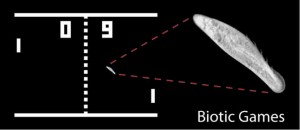Ingmar Riedel-Kruse and colleagues from Stanford University have developed games which use a
biological system as an essential component in a microfluidic device. These range from a soccer game in which live Paramecium cells are directed to kick a tiny football into a goal, to a new version of the classic pacman in which the player controls live paramecia to collect virtual yeast food while avoiding the virtual zebra fish larvae! There’s also a betting game based on a realtime PCR system.
Commenting on the games Steve Quake, also from Stanford, points out that they could prove serious fun with applications in school education as well as in medical applications e.g. serving as early diagnostics for neurodegenerative diseases such as Alzheimers and Parkinsons.
Design, engineering and utility of biotic games
Ingmar H. Riedel-Kruse, Alice M. Chung, Burak Dura, Andrea L. Hamilton and Byung C. Lee
Lab Chip, 2011, Advance Article
DOI: 10.1039/C0LC00399A, Paper















![c004675b_for_Tridion_300_tcm18-186278[1] Artery on a chip](https://blogs.rsc.org/lc/files/2010/07/c004675b_for_Tridion_300_tcm18-1862781.jpg)